Terry Reese: Blessed to be a Hurdler
“If you can find a path with no obstacles, it probably doesn’t lead anywhere.”
–Frank A. Clark
Introduction
Picture this: It’s 1991, you’re walking past Paul Derr Stadium at North Carolina State University in Raleigh, NC on a weekday morning, and you look down the bleachers to the track, where you see a solidly-built African American training over a set of hurdles by himself. Then flash forward, let’s say twenty years, to 2011, and you see the same picture. Then flash forward again, let’s say to last Friday, and you see the same picture. Are you getting the picture? That lone hurdler you saw out there twenty-plus years ago is the same hurdler you saw last week: Terry Reese. To paraphrase a line from Forrest Gump, that boy sure is a hurdlin’ fool.
The owner of a personal best of 13.22 in the 110 meter high hurdles, Reese’s accomplishments in the sport of Track & Field are many. In 1995 he finished the year ranked 8th in the world after finishing fourth at the USA Championships. In 1997 he finished third at the USA Championships, and later that same year finished sixth at the World Championships in Athens, Greece. He competed in three Olympic trials (1988, 1996, 2000), and in 1998 was a member of a the world-record-setting shuttle hurdle team that included Duane Ross, Steve Brown, and Allen Johnson.
Currently self-employed as a speed coach for athletes of all sports, Reese coached for nineteen years at his alma mater (1992-2011) after graduating from NC State with a degree in Communications in 1990.
In His Brother’s Shadow
While much of Reese’s athletic journey has taken place in North Carolina, it began in Orlando, Florida, where he was born on June 20, 1967. A member of the class of 1985 at Oak Ridge High School in Orlando, Reese began hurdling while still an 8th-grader at Westridge Junior High. As the younger brother of stand-out athlete Kelvin Reese, it was only a matter of time before Terry, four years younger than his oldest brother, would literally follow in Kelvin’s footsteps.
“The coach came looking for me,” Reese explained, “because he knew of my older brother. Kelvin played football, wrestled, ran the hurdles. My seventh grade year, I didn’t go out for track. But my eighth grade year I decided to go ahead and give this thing a try. I started off looking as bad as anyone else. I was long-jumping over the hurdles, taking five steps between.”
[am4show not_have=”g5;”]
[/am4show][am4guest]
[/am4guest][am4show have=”g5;”]
But after those initial falterings, progress came quickly, and a passion developed. “It just became one of those things I wanted to get better at,” he said. “I wanted to do it better than my older brother.” Kelvin ended up running 13.97 as a personal best in his senior year. “I also did the long jump and triple jump throughout high school. But my main focus was always the hurdles. I always believed I had the ability to go far, but I knew it was gonna take a lot of hard work.”
But even with putting in the work, Reese never ran as fast as Kelvin in high school, finishing his prep career with a personal best of 14.11. Not too shabby, but not among the country’s elite.
When deciding upon a college, he settled upon NC State instead of staying in Florida. He did so for a couple reasons. One, Kelvin was at NC State, and he wanted to reunite with his older brother. Also, most of the colleges in Florida, including the Florida Gators, were recruiting him for football as a free safety. But Reese didn’t want to play football anymore. Why not?
“There were a few incidents,” he explained, “when I went to make a tackle, and the running back went lower than me and hit my knee. I’d see teammates having knee problems. And you know, I like being able to walk. I like running.”
Also, Reese simply enjoyed track more than football. In addition to running for his high school team, he had run in the Junior Olympics in the summers, which gave him a chance to travel around the country to different meets. He liked the atmosphere, and he liked the work. “In football,” he said, “I used to hate going through a week of practice. I just looked forward to the game. In track, I enjoyed the work.”
Making a Name for Himself
His first two years at NC State, Reese placed in the hurdles at the ACC championships, but still didn’t break 14 seconds. Then finally, in 1988, his junior year, he ran under 14 for the first time. “Things really clicked, and then I was on a mission to be one of the best in the world at some point.”
That year, there were two national championship meets. There were the USA Championships, and then the US Olympic Trials in back-to-back weekends in June. Reese qualified for both meets, and suddenly saw himself lined up against some of the best hurdlers in the world. “Roger Kingdom. Tonie Campbell. Greg Foster. It was amazing to see those guys. It was my first time experiencing being in that atmosphere. My mindset was, there’s no turning back.” At the Trials, Reese made it to the semi-final round, where he finished seventh in his heat. But the experience prepared him to compete at the top level, among the hurdling elite. He was one of only two collegians to make it to the semis that year, the other being one of Reese’s rivals, Eric Cannon of the University of Pittsburgh.
In Reese’s senior year, there were more obstacles to face, including a nagging hamstring injury. But he continued to progress, qualifying for NCAA nationals, where he finished 7th in the finals. He finished his collegiate career as the school record holder in the 55 meter hurdles (7.17) and 110 hurdles (13.60). So while he hadn’t run fast enough to earn a contract and run professionally, he had run too fast to just give up on the sport and move on. So he stayed at NC State and trained by himself while also serving as a volunteer coach for the track team and working in the athletic dormitory as a full-time member of the maintenance crew.
Reese quickly discovered that the lifestyle of the non-professional post-collegiate athlete is not conducive to running fast times. “I was trying to get to the next level, but I’m doing all this physical labor in my job, then going to train. I couldn’t break 14 seconds.”
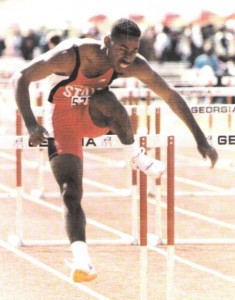 Reese competes as NC State’s lone high hurdler during his sophomore year (1987).
Reese competes as NC State’s lone high hurdler during his sophomore year (1987).
While many athletes would have given in to despair by this point, Reese “still had it in my mind I was gonna make this thing work.” But it was tough. He couldn’t afford to travel far, so most of his meets were local. He’d run in college meets as an unattached athlete. He recalls one time running in a meet at the University of North Carolina and getting beaten by Qadry Ismail, better known for his prowess on the football field. Ismail, who was competing for Syracuse University at the time, had been a Pennsylvania state champion in high school. He would later go on to play professional football for the Minnesota Vikings and Baltimore Ravens.
“So after the race we’re talking, and he’s saying he’s having fun just doing this as sort of a hobby. And I’m thinking, here I am giving it my all, running 14 flat, and he’s beating me doing it as a hobby.”
Without a coach and with no training partners, Reese was struggling. But then one of the athletes he was coaching, Reggie Barnes, made the World Junior Team, which opened the door to a promotion. “The sprint coach resigned,” Reese explained, “so I was able to move from volunteer coach to sprint/hurdle coach. I wanted to coach on the college level because, as a college athlete, I’d been the only short hurdler on the team, so I used to train a lot with the jump crew. I had my hurdle days, and I worked out with the jumpers on other days. Combining the jumping workouts with the hurdling workouts became part of my training philosophy. The jump training and the strength and coordination you get from that, combined with the hurdle training, made for a good blend. After getting that job, things started to turn around. No more maintenance work, cutting grass, painting. I started to get back into it. Actually started to run sub-14 again. I ran 13.74 that year.”
From Also-Ran to World Class
That year was 1993. The following year, 1994, Reese met Trevor Graham, coach of the Sprint Capitol group that would later go on to dominate on the world stage in the sprint events. However, the training group would also become infamous for drug-related scandals involving athletes such as superstars Marion Jones and Tim Montgomery, among others. Reese steered clear of the mayhem and focused on his training and on coaching his own athletes on the college team.
What impressed Reese when he saw the Sprint Capitol athletes training on the NC State track was how hard they worked. He’d be training by himself on one side of the track while they trained together on the other side. On several occasions Graham offered to take on Reese, but Reese was hesitant at first. “Finally,” though, “I just crept on over there. Their training philosophy seemed to gel with mine. Put in work.”
Under Graham’s guidance, Reese dropped his personal best down into the 13.40 range. For the first time since graduating four years earlier, Reese now had a group of athletes to train with, and a competitive environment in which to thrive. “I was already a hard worker,” Reese said, “and the way that Trevor trains is hard work.”
Also, although Graham was known for his prowess as a sprint guru, he proved to be an invaluable asset when it came to critiquing Reese’s hurdling. “Having those eyes on me had an immediate impact on my ability to elevate to the next level,” Reese said. “I give him credit for having a keen eye. He ended up becoming a good hurdle coach. Having another set of eyes on me, besides my own, it was like night and day. He’d pick up on little things here and there that made a ton of difference.”
Two years later, Duane Ross, who had just finished up a stellar career at Clemson University, joined the group, and Reese had the first hurdling teammate of his professional career.
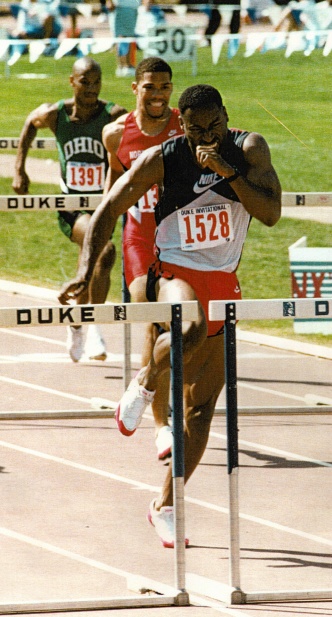 Reese competes as a professional at the Duke Invitational in 1995. One of his athletes, Jaosn Perry, trails him in the background.
Reese competes as a professional at the Duke Invitational in 1995. One of his athletes, Jaosn Perry, trails him in the background.
The year before Ross’ arrival in 1996, Reese broke through into the realm of world-class hurdlers. At the 1995 USA Championships in Sacramento, he ran a wind-aided 13.23 in the semi-final round, then went on to finish fourth in the finals, just missing qualifying for the World Championship team. Then, for the first time in his career, he traveled to Europe and raced overseas throughout the summer. He dropped his non-windy personal best down to 13.33, and finished the year ranked the 8th-best high hurdler in the world.
And he did all this while keeping up with his duties as the NC State sprint/hurdle coach. “I would say I was a full-time track coach and part-time athlete,” Reese said. “I got the work in, but didn’t get the opportunity to say that training is all I do. When everyone else is done with practice, I’m still at the track. I’m coaching. I’m going out recruiting. At certain times of the season, I could be at the track all day.”
Despite the demands on his time and energy, Reese continued to improve. In 1997, he made his first international team, placing third at the USA Championships. At the World Championships in Greece, he made it to the finals, where he finished sixth. To cap it all off, he dropped his personal best all the way down to 13.22 in a meet in late August in Koln, Germany.
In describing that race, in which he finished second to Mark Crear, Reese made the following observations:
“Prior to that meet, I had run a few races around that same time. After Worlds, things just started to really click. When I ran the 13.22 I was in lane 2, with all the competition on the inside of me. I noticed that I have a technical issue when I hurdle. My head will drift away from my lead leg, then swirl back over the top. When my competition is on my right side (the side of his lead leg), that minimizes that. I stay on top of that lead leg, riding that lead leg. Most of my best races came when I was in lane 1 or lane 2. So when my agent signed me up for the meet, I asked him to get me either lane 1 or 2. Getting in 2 definitely helped. It was one of the rare occasions when I finished ahead of Allen Johnson. He had a bad race that day, and I had the best race of my life.”
Having run his personal best into a slight headwind of -0.2, Reese believed he could go even faster. But it never happened, and he’s not sure why. Part of the reason, he thinks, has to do with not having world class sprint speed, and the other part has to do with not being able to put 100% focus into his own career due to his coaching responsibilities. “I’d say my speed was probably in the 10.4 range,” he said. “I definitely wasn’t a 10.0 or 10.1 guy.” And while NC State head coach Rollie Geiger was very flexible in allowing Reese to travel overseas to compete, Reese found that not having the freedom to devote all his physical and mental energy to mastering his own race led him to lack trust in himself when it came to pushing past mental barriers that hurdlers face as they drop time and must sharpen their reactive abilities. “I never trusted what I was doing enough to push past that 13.22 point,” he said.
The last major achievement of Reese’s career came the following year, in 1998, when he joined forces with three other ACC hurdling alums – Ross, Johnson (UNC), and Steve Brown (Wake Forest) – to form a sensational shuttle hurdle relay team. They competed together at the Orange & Purple Classic at Clemson University on May 16th. The four hurdlers were preparing for the national championships that would take place within a month, and the Clemson team, having run fast a few weeks earlier at the Penn Relays in Philadelphia, was looking to break the collegiate record.
When Ross approached Reese with the idea of putting together a shuttle hurdle team, Reese’s reaction was a resounding “Yes!”
“I had never been a part of a hurdle relay,” he explained, “because I was always the only hurdler on my team in college. So I was like, Oh shoot, we can get that world record.”
The order: Brown first leg, Reese second leg, Ross third leg, Johnson anchor leg. The four-man crew dominated from the gun and never looked back. Johnson crossed the line in 53.62, and the ACC Alums had set a new world record. It would last ten years, when a Florida-based group consisting of David Oliver, Aubrey Herring, Joel Brown, and Aries Merritt dropped the record down to 53.31 at the 2008 Penn Relays.
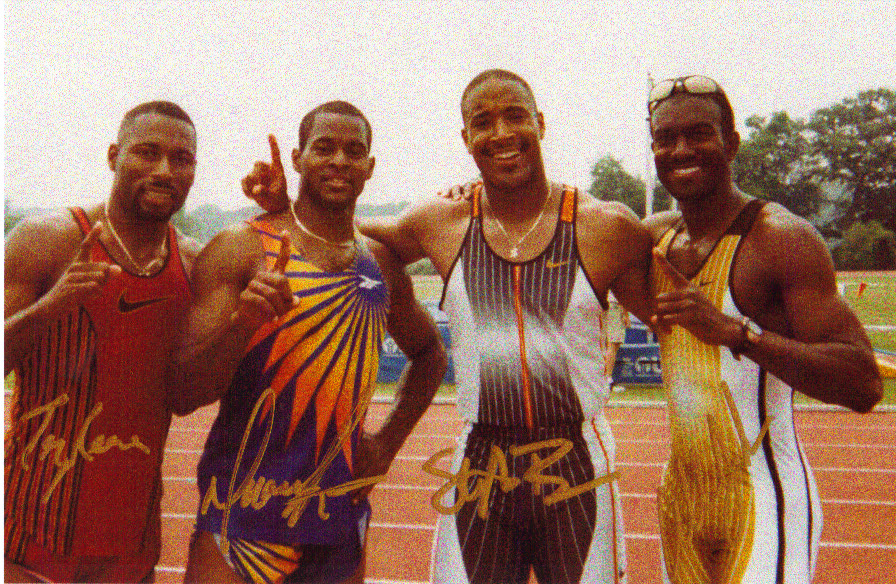 The record-setting all-ACC-alum shuttle hurdle team, from left to right: Reese, Ross, Brown, and Johnson.
The record-setting all-ACC-alum shuttle hurdle team, from left to right: Reese, Ross, Brown, and Johnson.
When reflecting back on his career, Reese has no regrets. He worked hardest when times were hardest, and he never backed down from a challenge. When asked to describe himself as a hurdler, he said that he was a combination of speed, power, and technique. His greatest technical asset was his trail leg. He recalls two incidents when he was paid a compliment by none other than coaching legend and author of The Hurdler’s Bible, Wilbur Ross.
“I saw him my junior year at a meet in Tennessee,” Reese said. “He was coaching Jack Pierce and Tony Dees (two of the top American hurdlers in the early ‘90’s, after the reigns of Kingdom and Foster, before the rise of Johnson). I ended up finishing third in 13.60. And you know Ross was a big trash talker. He walks by me and says, ‘Who’s this young buck right here?’”
The other time, Ross was coaching Steve Brown, and the two of them were out on the track at NC State when Reese arrived at the facility. Upon seeing him, Ross commented, “Mr. Reese, boy, he got the fastest trail leg in the west!” Reese, appreciative of the compliment, later went back and watched video of some of his races, and noticed that his trail was indeed very fast. “Tony Dees got his lead leg down before mine, but our trail legs touched down at the same time.”
Coach Reese
As a coach, Reese believes in designing training programs that fit the needs of the individual athlete. Over the years he learned that trying to fit every athlete into the same plan doesn’t work. “Initially,” he said, “you think your way is the only way. But I quickly evolved – from ‘This is how we’re gonna do it’ to realizing I can’t do particular things with every athlete. You have to tap into different ways to get through to the athlete.”
Throughout his career as a coach at NC State, Reese would sit down with each athlete at the beginning of each school year, print out a goal sheet, then have a one-on-one with the athlete after he or she filled it out. “With freshman straight out of high school, I like to find out what type of workouts they’ve done in the past and see how we can incorporate the things I like to do to help them improve. In fall training, you can see the strengths and weaknesses of different athletes. A lot of times you can stick with general stuff, but you’ll have to supplement it with things that will be beneficial to the person and get rid of things that are detrimental.”
Although quiet and subdued by nature, Reese isn’t afraid to assert his authority when the occasion calls for it. “If I ask [an athlete] to do something, I wanna see you giving it a shot. If it doesn’t work, the person to blame is me. But if you don’t do it, then it’s on you. There’ve been cases where I admitted I was wrong. Whenever I’ve done that, it lets the athletes know I care about their well-being. And I get more trust out of them.”
Reese feels that the fall season is the most important time to build relationships and to put a concrete plan in place. “You want to catch things early enough to make the proper revisions and see that progress is made. My coach’s eye has always been there to pick up on things, but it’s definitely gotten better. I used to let things go a little while before I’d step in and say something. Now it’s like, ‘Let’s stop right there, back up a little bit so we can move forward again.’”
Although NC State’s distance-based program didn’t heavily recruit sprinters and hurdlers, Reese coached many outstanding athletes during his tenure as their sprint/hurdle coach, but none more so than female 100m hurdler Ebony Foster from Lynchburg, VA. Ironically, she did not come to him as a hurdler, but as a sprinter and jumper.
“All of my group trained together through fall training,” Reese explained. “Except the longer sprinters may go on some longer runs. The strength and coordination was the same for everyone. I noticed early on that Ebony had strength and coordination like a hurdler. Through the indoor season I let her focus on sprinting. Then at the end of the indoor season, I had her pop over a couple hurdles and see if she had some possibility. I had her do a rhythm run over hurdles I had tipped over. She looked good, so I raised the height, gave her a few instructions. Again, not bad at all. I put her in a hurdle race early in the season, at the Raleigh relays right there on campus, at the end of March. She ran 14.3 her first time ever running the hurdles.”
In her second race Foster ran around the same time. At the ACC Championships in late April, she “ran 13.6 in the trials. 13.5 in the finals,” according to Reese. After red-shirting the indoor season of her sophomore year, she went on to win ACC’s outdoors, qualify for nationals, and ended up going to the Olympic Trials. “She was on fire,” Reese said. At the Trials, she ran 12.81 in her semi-final heat, “with Gail Devers in the lane next to her,” good enough to qualify for the final. In her final two years at State, she won the NCAA East Regional, and she qualified for the finals at the NCAA and USA National Championships.
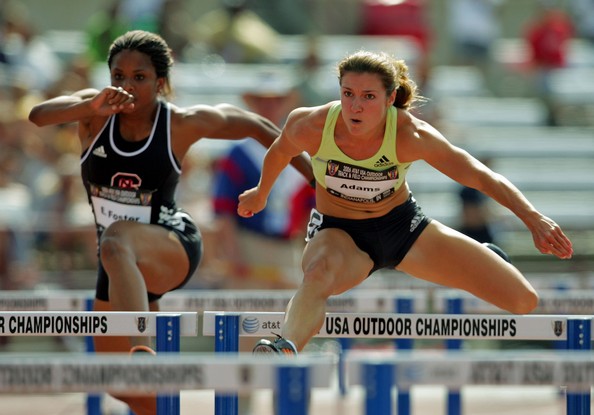 Ebony Foster (left) races against Jenny Adams at the 2006 USA Championships.
Ebony Foster (left) races against Jenny Adams at the 2006 USA Championships.
Like many of Reese’s former athletes, Foster, to this day, still looks upon him as a valued mentor and father figure.
For the Love of the Hurdles
At age 46, well past his prime years as one of the fastest hurdlers in the world, Reese still trains regularly and keeps himself in the best of shape. You won’t find many 46-year-olds who can get over a hurdle higher than a rock, but Reese still does drills and workouts in which he clears the 36, 39, and even the 42-inch barriers with relative ease and with remarkably precise technique. As someone who is only several months older than Reese, all I can say is, ouch. It’s a long way down from those 42’s. On non-hurdle days, he puts himself through sprint workouts consisting of various distances, usually in the 100-300 meter range, usually adding up to somewhere in the range of 1800 meters worth of reps.
When considering Reese’s training regimen, two questions come to mind: how does he still do it, and why does he still do it? His answers for both questions are quite simple.
“I never stopped,” he said. “For me, the whole thing is, I can. That’s why I still do it – because I still can. And I actually love doing it. That’s the main reason I do it. When I was doing it on an elite level, I was doing it for the same reason. It was never about the accolades and the money. I love hurdling, and I love the competitive environment. That’s my biggest blessing right there.”
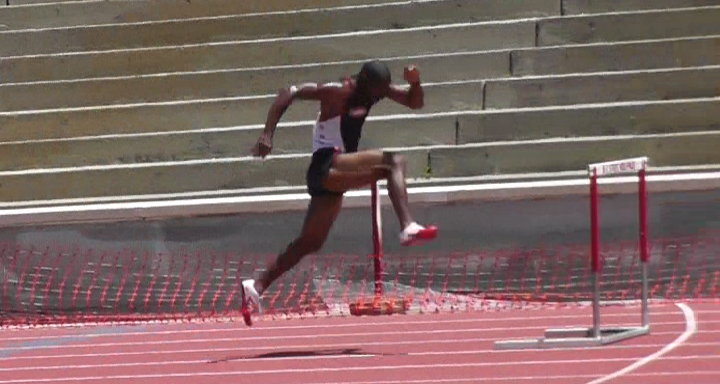 Reese celebrates his 44th birthday over the 42’s two years ago.
Reese celebrates his 44th birthday over the 42’s two years ago.
Reese’s advice for young hurdlers seeking to maximize their potential mirrors the approach he has taken throughout his own life when it comes to overcoming obstacles:
“Be committed, passionate and willing to put in the work. And with the hurdles, you have to have some patience in your development. Hurdling is a way of life for us. When you get the mindset of a hurdler, any obstacle you see in your way, simply hurdle it in stride.”
***
Terry Reese’s YouTube channel: http://www.youtube.com/channel/UCgOHG1xEaSxD3NGjPBzc3lg
Terry Reese’s Twitter page: https://twitter.com/TeeReeseJr
Terry Reese’s blog: http://offtrackthinking.blogspot.com/
[/am4show]
